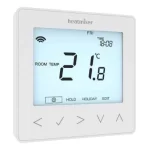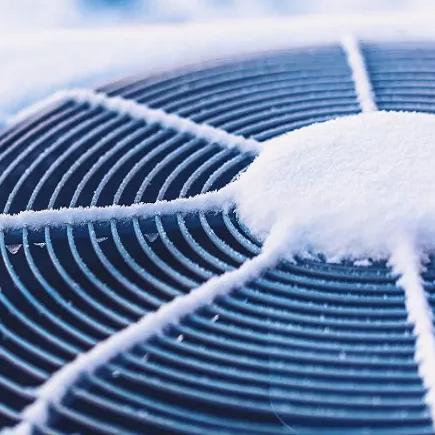
How to Winterize Air Conditioners?
As the days grow shorter and the crispness of winter approaches, it’s time to start thinking about protecting your air conditioning system from the harsh elements. While many associate air conditioners solely with cooling, these units also require attention during the colder months to ensure their longevity and optimal performance once the warmer weather returns. Proper winterization is crucial to prevent damage and maintain efficiency, whether you have a central air system, a window unit, a ductless mini-split, or any other air conditioner. This article will show you how to winterize air conditioners.
Every AC unit demands unique preparations to remain in top-notch condition, from safeguarding against freezing temperatures to preventing dust and debris buildup. By taking the time to winterize your air conditioner properly, you can save on repair costs, extend its lifespan, and ensure your indoor comfort when summer comes around. Join us as we explore the tailored approaches to winterization that will keep your air conditioner running smoothly for years to come.
How to Winterize Central Air Conditioning Systems?

1. Turn Off the Power: Winterize air conditioners by switching off the power supply to your central air conditioner. Locate the circuit breaker or disconnect switch dedicated to your AC unit and turn it off to ensure safety during maintenance.
2. Clean the Exterior: Clear any debris, leaves, or vegetation around the outdoor condenser unit. Trim nearby plants to maintain proper airflow and prevent obstructions.
3. Inspect and Clean the Coils: Gently remove the unit’s top grille or access panel to expose the coils. Carefully inspect them for dirt, dust, and grime. Utilize a gentle brush or a coil-cleaning solution to cleanse the coils, adhering to the instructions provided by the manufacturer.
4. Cover the Unit: Invest in a weatherproof cover designed specifically for central AC units. This cover will shield the condenser from snow, ice, and debris while allowing proper ventilation.
5. Seal Ducts and Openings: To winterize air conditioners, you should inspect your home’s ductwork for gaps or openings that let cold air in. Seal these gaps using foil tape or mastic sealant to prevent energy loss and drafts.
6. Change the Air Filter: A clean air filter ensures efficient airflow and reduces strain on your system. Replace the old filter with a new one to maintain indoor air quality and system performance.
7. Consider Professional Maintenance: If you need more time to winterize air conditioners, consider scheduling a professional HVAC technician to conduct a thorough winterization and maintenance check. They can detect possible problems and ensure that your system is winterized.
8. Set Thermostat to “Heat” Mode: Adjust your thermostat to the “heat” mode and a lower temperature setting for the winter. This conserves energy and prevents the AC from turning on during warmer winter days.
9. Monitor Throughout Winter: Occasionally check the outdoor unit to ensure the cover remains secure and debris-free. Also, monitor the indoor unit for any signs of dust or dirt buildup.
How to Winterize Window Air Conditioners?
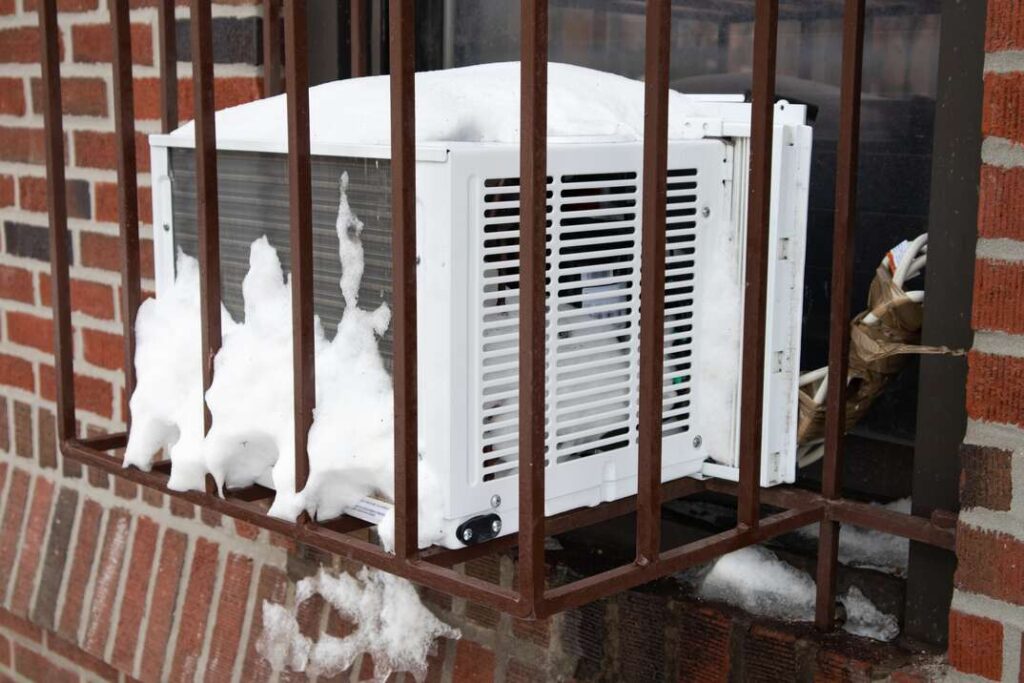
1. Remove and Store: If your window air conditioner is designed to be easily removable, carefully take it out of the window. If it’s a permanent installation, proceed with the steps below.
2. Clean the Unit: Thoroughly clean the air conditioner’s interior and exterior. Remove accumulated dust, dirt, and debris to prevent mould growth and improve efficiency.
3. Insulate Gaps: If your window AC has gaps around it, seal them with weatherstripping or foam insulation. This helps prevent drafts and keeps warm air from escaping your home.
4. Cover the Exterior: Purchase an appropriate AC cover or use a tarp to protect the exposed exterior part of the unit. Secure it tightly to prevent snow, ice, and debris from accumulating.
5. Disconnect Power: If the unit has a dedicated power supply, turn it off and unplug it to prevent any potential electrical issues during the winter.
6. Interior Protection: If your window AC unit is not removable, you can insulate the interior side of the unit. Use an insulating foam panel or cover to minimize heat loss and drafts.
7. Regular Check-ins: Periodically check the exterior cover to ensure it remains secure. Remove any snow buildup that may accumulate on top of the cover.
8. Spring Maintenance: Once the warmer months return, carefully remove the cover, clean the unit, and inspect it for potential damage before re-installing it.
9. Professional Check-up: If your window air conditioner had any issues during the previous cooling season or has been used for a few years, consider having a professional HVAC technician perform a maintenance check before summer arrives.
10. Consider Storage: If you have the space, storing the unit indoors during the winter can provide extra protection and extend its lifespan.
How to Winterize Ductless Mini Split System?
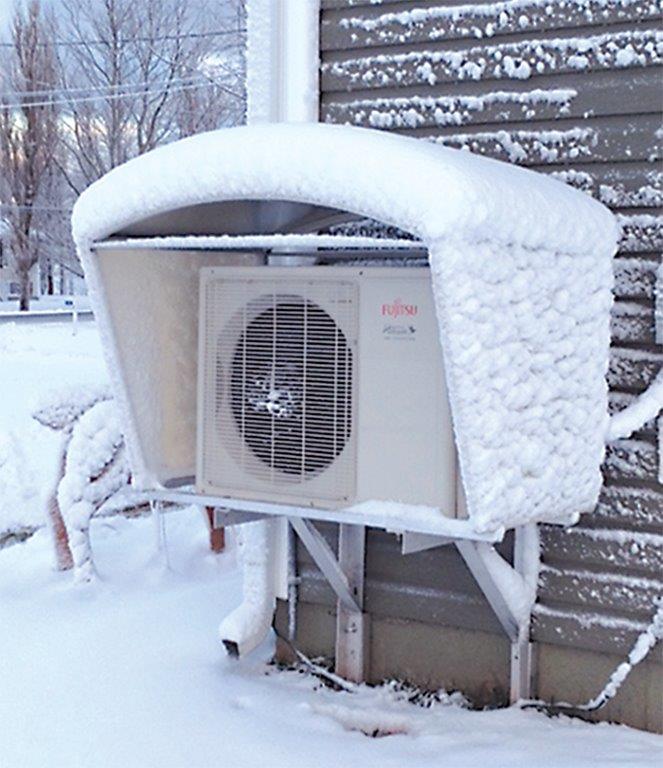
1. Clean the Filters: To winterize air conditioners, clean or replace the filters in the indoor air handling unit and the outdoor condenser. Clean filters allow for better airflow and help maintain indoor air quality.
2. Inspect for Leaks: Check the refrigerant lines and connections for any signs of leaks. If you notice any leaks, addressing them before winter sets in is crucial.
3. Clear the Area: Trim any vegetation or debris around the outdoor condenser unit to ensure proper airflow and prevent obstructions.
4. Protect the Outdoor Unit: If you experience heavy snowfall in your area, consider installing a protective cover over the outdoor condenser. This cover should allow proper ventilation while shielding the unit from snow and ice.
5. Set the Thermostat: Adjust the thermostat settings to reflect winter’s lower temperatures. While you want to maintain a comfortable indoor environment, lowering the temperature slightly can help conserve energy.
6. Check Insulation: Inspect the insulation around the refrigerant lines and ensure it’s intact. Proper insulation prevents heat loss and maintains the efficiency of the system.
7. Keep Indoor Units Clear: Ensure that furniture, curtains, or other items are not blocking the airflow from the indoor air handling units. Precise airflow improves efficiency and performance.
8. Schedule Professional Maintenance: Consider having a professional HVAC technician perform a thorough maintenance check before winter. They can identify potential issues and ensure the system is in optimal condition.
9. Monitor Regularly: Occasionally, check the outdoor unit throughout the winter to ensure it’s free from snow and debris. Also, monitor the indoor units for any signs of decreased performance.
10. Spring Preparation: As spring approaches, remove any covers from the outdoor unit and inspect the entire system before transitioning back to cooling mode.
How to Winterize Portable Air Conditioners?
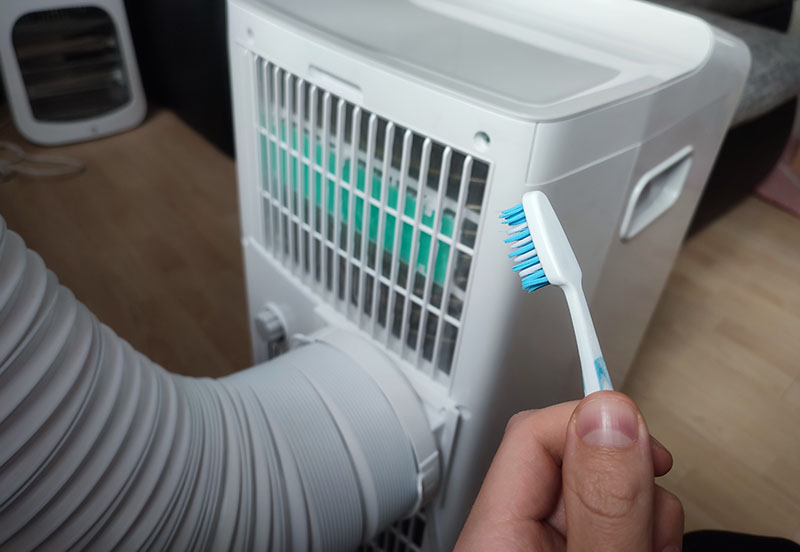
1. Clean the Unit: Before storing your portable AC, thoroughly clean it. Remove and clean the air filter, and wipe down the exterior to remove any accumulated dust or debris.
2. Drain Condensate: Portable air conditioners dehumidify the air as they cool, resulting in condensate buildup. Many units have a drain plug or pan that can be emptied. Ensure it’s drained to prevent mould growth and odours.
3. Inspect Exhaust Hose and Window Kit: If your portable AC has an exhaust hose and window kit, remove them carefully. Inspect the hoses for any damage or cracks and clean the window kit components for storage.
4. Store Components Together: To prevent any pieces from getting lost, store all components together, including the remote control, exhaust hoses, window kits, and user manual.
5. Select an Indoor Storage Spot: Store your portable air conditioner indoors to shield it from extreme temperatures. A closet or storage area works well if it’s dry and well-ventilated.
6. Cover the Unit: If storing outdoors is your only option, invest in a cover specifically for portable air conditioners. This cover will protect the unit from the elements and debris.
7. Regular Check-ins: Occasionally check the unit during winter to ensure the cover remains secure and to confirm that no critters have taken up residence.
8. Spring Maintenance: As winter fades, retrieve your portable air conditioner and perform a thorough inspection. Clean the air filter, inspect the hoses, and test the unit to ensure it’s in proper working condition.
9. Professional Check-up: If you encountered any issues during the previous cooling season or have been using the unit for several years, consider scheduling a professional maintenance check before the heat returns.
10. Energy-Saving Mode: Some portable air conditioners have an energy-saving mode acting as a heater during winter. If your unit has this feature, it can help regulate the room’s temperature while saving energy.



